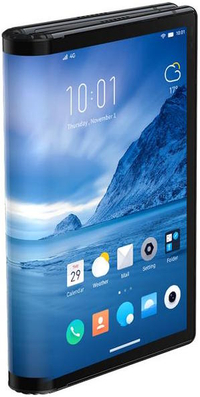Foldable smartphones: Rumored release dates, prices and specs
A growing number of device makers are touting foldable smartphones. Find out just what's available and how these devices compare to one another.
A new trend in smartphone design is unfolding right before our eyes.
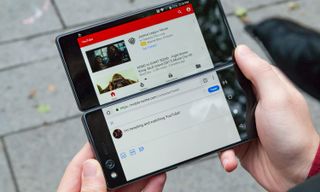
After a decade of putting out candy-bar-style slabs, phone makers are looking to shake things up. And if expansive, bezel-free displays don't grab you, companies are hoping that devices with bendable screens will.
Samsung is the latest to unveil a foldable smartphone, but it's certainly not the first company to do so — nor will it be the last. By making devices with expandable displays, phone makers hope to meet the needs of people who increasingly view that device in their pocket as their primary way of getting things done. And if these new designs happen to give a jolt to smartphone sales, all the better.
Here's an overview of all the foldable smartphones that have been announced and how they compare to one another.
| Phone | ZTE Axon M | Royole FlexPai | Samsung Infinity Flex Phone |
| Price | $724.99 | $1,318 | Unknown |
| Unfolded Screen Size (Resolution) | 6.5 inches (2160 x 1920) | 7.8 inches (1920 x 1440) | 7.3 inches (2152 x 1536) |
| CPU | Snapdragon 821 | Snapdragon 8 Series | Unknown |
| RAM | 4GB | 6GB, 8GB | Unknown |
| Storage | 64GB | 128GB, 256GB | Unknown |
| Cameras | 20MP (f/1.8) | 16MP/20MP (f/1.8) | Unknown |
| OS | Android 7 Nougat | Android 9 Pie | Android 9 Pie |
| Availability | Now Shipping | December 2018 | Unknown |
Samsung Infinity Flex Phone
Why you can trust Tom's Guide
After years of rumors, hints and teases, we finally got a look at Samsung's foldable phone when the company offered a sneak peek at its annual developers' conference. And yet, even after seeing the phone out in the wild, there's still plenty we don't know about it.
Let's start with the name. Samsung hasn't told us what it's calling this phone, simply referring to the device's Infinity Flex display during that developers' conference preview. Rumors had Samsung naming the phone the Galaxy X or Galaxy F; we have no idea which of those two options the company will take or if it has a different name entirely in mind.
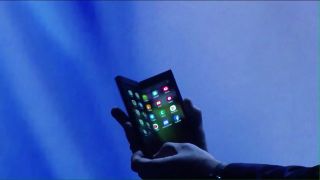
If you're wondering what processor powers the phone, continue to speculate. Samsung hasn't talked about that, how the cameras might work or even what the physical dimensions of its Infinity Flex phone are. The phone was visible only from a darkened keynote stage, so we'd have to guess this is an early prototype.
We do have a good idea of just how the phone will unfold, though. Samsung's device will open and shut like a book. When the handset's open, you're looking at a 7.3-inch AMOLED screen that offers more detail than what you'd get from a standard smartphone display. Fold up the phone, and you've still got a 4.58-inch cover display with the same touch-screen functionality you've come to expect from a mobile device.
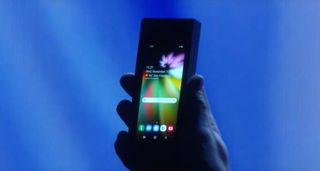
The phone will run a version of Android designed to support foldable devices, and Samsung is touting a couple of neat software features. App continuity means that the app you're looking at on the smaller, cover screen will remain open on the full display when you unfold the phone — the part of the app you were looking at will even be front and center. You'll also be able to multitask on Samsung's phone, because the Multi-Active Window feature lets you run three apps side by side.
MORE: How Apps Will Look on Samsung's Wild Foldable Phone
When Can I Get It? Samsung says it's ready to start mass production on its foldable display in the coming months, though there's no explicit timeline. We'd guess that Samsung will have a fully fleshed-out foldable phone sometime in 2019.
What Does It Cost? That's an even bigger mystery. The rumors building up to the unveiling of the Infinity Flex display suggested that the phone would be in the ballpark of $1,800. That's a pretty expensive device, but consider that Samsung sells the Galaxy Note 9 for $999, and the phone's screen doesn't fold at all. Expect to pay more for a device sporting breakthrough technology.
FlexPai
Samsung's announcement of a folding phone grabbed all the headlines, but that company's device is not the only foldable smartphone to debut this year. A week before the Infinity Flex announcement, a little-known company named Royole unveiled the FlexPai, which also has a foldable screen. And Royole is already taking orders on its device.

The FlexPai works a little differently from Samsung's phone. Instead of folding like a book, the FlexPai's 7.8-inch display folds downward, leaving you with a screen on either side of the device. It looks the hinge of the FlexPai is an active screen as well when folded.
Royole contends that the folded-up phone fits in your pocket, though it still looks pretty bulky to us, based on the hands-on videos posted since the phone's Oct. 31 debut. At 7.5 x 5.3 x 0.3 inches and 11.3 ounces, it's certainly not a slender device.
The FlexPai enjoys another advantage over Samsung's phone besides beating it to market: Royole has posted the actual specs. The folding phone runs on a Snapdragon 8-series system on a chip — Royole doesn't specify which Qualcomm chipset — with either 6GB or 8GB of RAM.
You've got a pair of cameras on one corner of the device: a 16-megapixel lens and a 20-MP shooter. And a dual-view camera modes shows you the photo from each screen should you have the FlexPai folded. A 3,800-mAh battery powers the phone, and that unfolded AMOLED display offers 1920 x 1440 resolution.
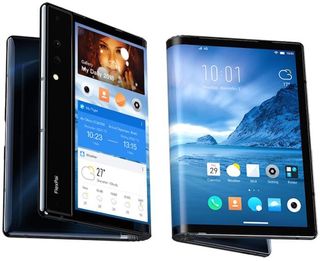
People who've seen the FlexPai in action say the phone is a little rough around the edges, and the videos posted online tend to support that verdict. A big problem seems to be that the FlexPai has trouble recognizing the orientation of the device when it's folded up, switching between landscape and portrait modes willy-nilly. Royole has said it's still fine-tuning the Android 9-based Water OS that runs on the FlexPai.
When Can I Get It? You can order a FlexPai Developer Model from Royole right now if you're daring enough, but don't expect it to ship right away. As of this writing, Royole's website says that orders will be fulfilled starting in late December. That sounds a lot like the phone will arrive in early 2019.
What Does It Cost? A 128GB FlexPai Developer Model will set you back $1,318. The price climbs to $1,469 if you double the storage to 256GB. Expensive? Sure. But to put that figure in context, an iPhone XS Max with 512GB of storage costs $1,449.
ZTE Axon M
What if I told you that a folding phone is already available and that you could have bought it at any time in the last year? That would be the ZTE Axon M, which debuted in the fall of 2017 but hasn't really captured the attention of smartphone shoppers.
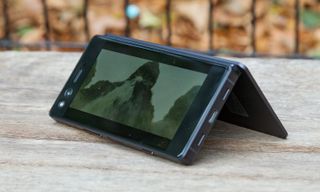
The Axon M isn't quite in the same class as the FlexPai or the foldable phone still in development at Samsung. Those phones feature screens that fold in two, whereas the Axon M is a dual-display phone that, when unfolded, positions those two LCD screens next to each other. The unfolded phone gives you a 6.5-inch display with 2160 x 1920 resolution and a visible hinge running down the center.

When we reviewed the Axon M, we liked the ability to run two apps side by side but were disappointed by the phone's lone, 20-megapixel camera and the device's subpar battery life. Also, the phone ships with Android Nougat, which is a little behind the times.
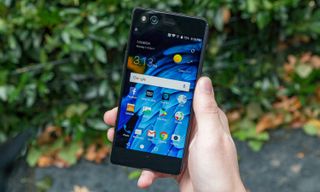
When Can I Get It? The Axon M is an AT&T exclusive, so you can buy it from that wireless carrier right now.
What Does It Cost? At least you won't have to pay a lofty price for the Axon M. ZTE's phone costs a relatively cheap $724.99 at AT&T. Buy the phone in installments, and you'll pay $24.17 a month for the next 30 months.
Other Rumored Foldable Phones
The parade of folding smartphones hasn't ended just because Samsung entered the scene. If anything, you should expect to see more of these bendable devices as we head into 2019.

Phone leaker Ice Universe predicted on Twitter that we would see foldable phones from "at least three smartphone brands" at the CES and Mobile World Congress trade shows — and that total didn't include Samsung.
So, who else has a folding smartphone tucked up their sleeve? Here are the rumors we've heard so far.
Huawei: This one isn't exactly a state secret. Huawei CEO Richard Yu has said that the Chinese phone maker was working on a foldable phone of its own — and that it would work on next-generation 5G wireless networks.
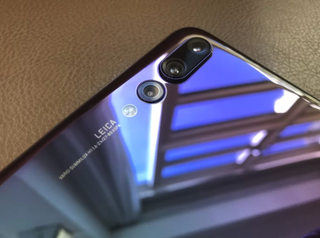
That last detail provides a hint as to when we can expect Huawei's foldable device. Most 5G wireless networks won't be ready until the first half of 2019, and that's only the initial rollout. Then again, nothing's stopping Huawei from offering a preview of the phone before 5G networking comes online.
LG: Evan Blass, another well-regarded leaker of smartphone details, contends that LG will have a foldable phone at CES in January. The story's not out of left field; like Samsung, LG makes displays, and in the past, the company has demoed panels that can fold, bend and roll up. Earlier this year, LG received a patent for a smartphone that folded shut. What's more, the manufacturer will deliver a keynote address at CES.
For its part, LG hasn't commented on the rumor. The company did tell Digital Trends that "anything is possible at CES."
Others: Back in 2016, Lenovo demonstrated a prototype phone that could bend around your wrist like a bracelet, as well as a 10-inch tablet that could fold in two. In the subsequent two years, Lenovo and its Motorola phone brand have been awarded their own patents for foldable devices.

Speaking of patents, Apple can point to its share covering foldable phone technologies and concepts. At least one analyst believes Apple will have its own folding iPhone out by 2020. As is typical, Apple is mum on its future phone plans.
Credit: Tom's Guide
Sign up to get the BEST of Tom’s Guide direct to your inbox.
Upgrade your life with a daily dose of the biggest tech news, lifestyle hacks and our curated analysis. Be the first to know about cutting-edge gadgets and the hottest deals.
Philip Michaels is a Managing Editor at Tom's Guide. He's been covering personal technology since 1999 and was in the building when Steve Jobs showed off the iPhone for the first time. He's been evaluating smartphones since that first iPhone debuted in 2007, and he's been following phone carriers and smartphone plans since 2015. He has strong opinions about Apple, the Oakland Athletics, old movies and proper butchery techniques. Follow him at @PhilipMichaels.
